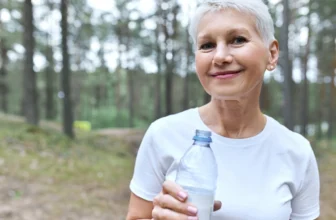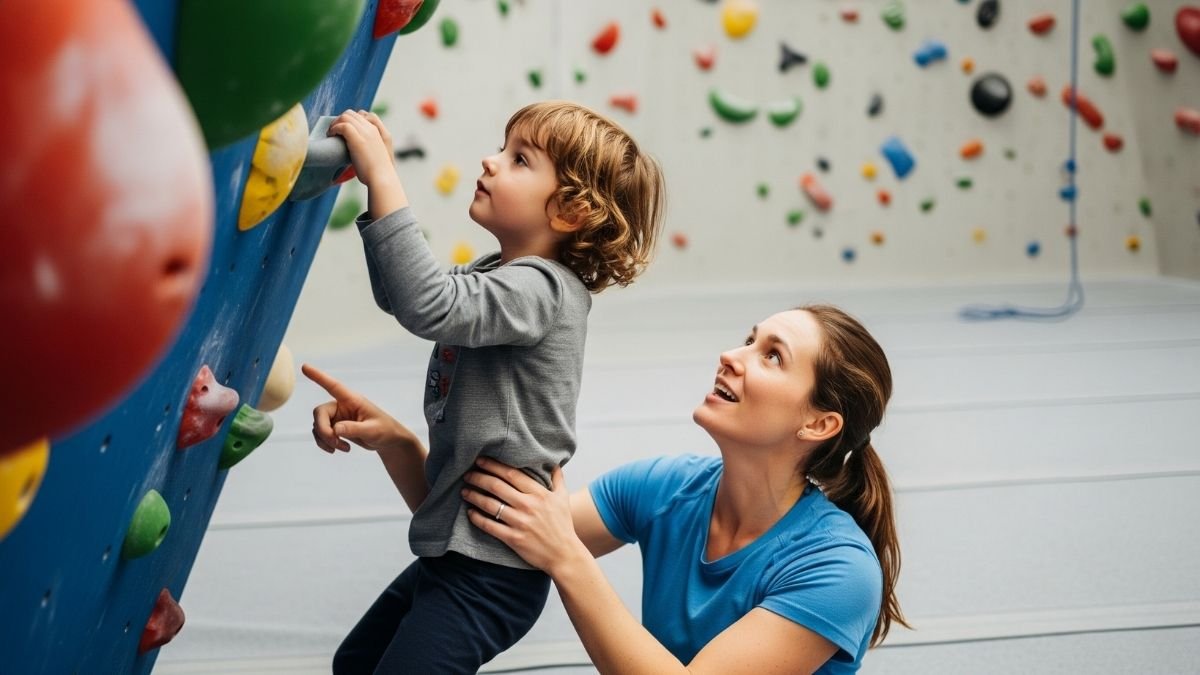
Your 5-year-old is climbing the playground equipment, getting higher than you’re comfortable with. Your heart starts racing, and before you can stop yourself, those two words fly out of your mouth: “Be careful!”
Sound familiar? You’re not alone.
But here’s the thing that might surprise you – child psychologists say those two little words could be making your child less safe, not more. And no, there isn’t some magical list of “13 phrases” floating around (despite what you might have seen on social media).
The real story is way more interesting than a simple listicle. Let’s dive into what the research tells us about raising brave, safety-aware kids.
The Problem with “Be Careful” (Spoiler Alert: It’s Bigger Than You Think)
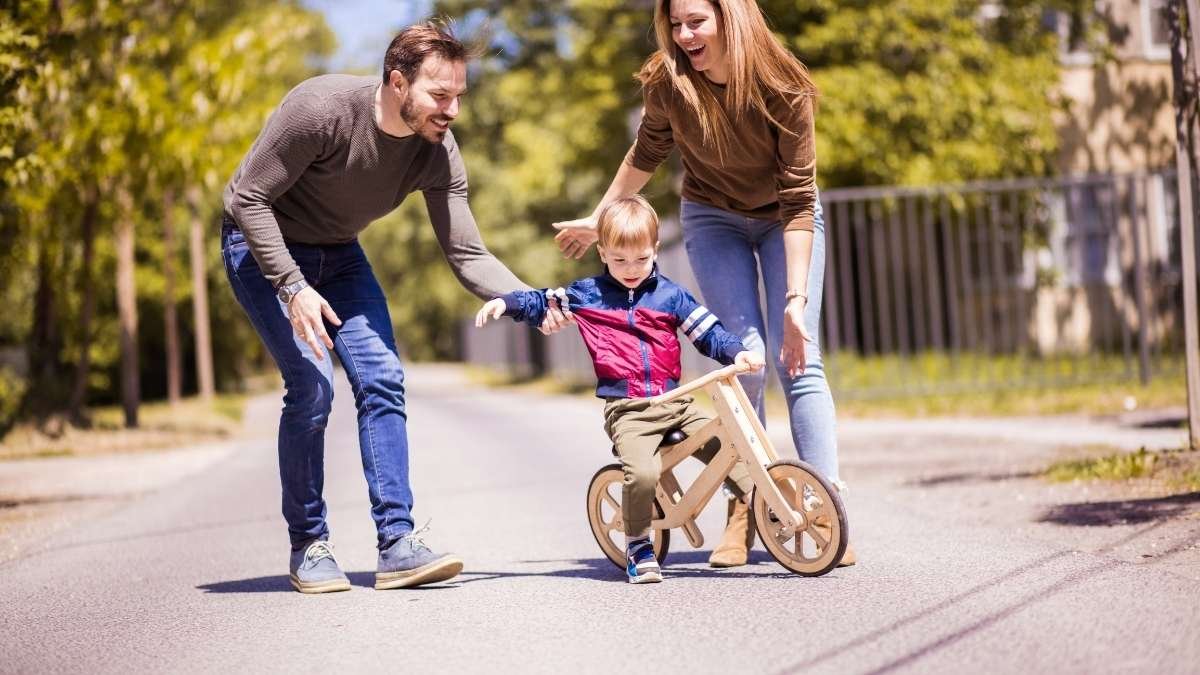
Dr. Eileen Kennedy-Moore, a clinical psychologist who wrote the book on kid confidence, puts it perfectly: “Be careful gives children no useful information. It only tells them, ‘I’m anxious, so you should be, too!'”
Think about it for a second. When you shout “be careful” at your kid, what specific information are you giving them?
Nothing. Zilch. Zero.
Instead, you’re just transferring your anxiety to their little developing brain. And here’s the kicker – research shows this can decrease their safety in the long run.
What Happens When You Say “Be Careful”
Your well-meaning warning creates three major problems:
1. It becomes white noise. Kids hear it so often that it loses all meaning. It’s like that car alarm that goes off in your neighborhood – after a while, you just tune it out.
2. It transfers anxiety without building skills. You’re essentially saying “I’m scared” without teaching them how to assess or manage the actual risk.
3. It discourages healthy risk-taking. Kids need graduated exposure to manageable challenges to develop proper risk assessment. When we constantly signal danger, we rob them of these crucial learning opportunities.
The Shocking Truth About Childhood Safety
12,000 children die annually from unintentional injuries
Here’s a statistic that’ll make you pause: Injury is the leading cause of death in children ages 1-19, accounting for 37% of all deaths. About 12,000 children die annually from unintentional injuries.
But here’s the plot twist – traditional safety approaches might be increasing risk, not decreasing it.
The “Stranger Danger” Wake-Up Call
Remember learning about “stranger danger” as a kid? Turns out, it’s making children less safe. The National Center for Missing & Exploited Children no longer supports this approach because it creates dangerous blind spots.
Here’s why: 90% of child abuse comes from people kids already know, not strangers. Plus, children who’ve been conditioned by “stranger danger” messaging often won’t seek help from safe strangers during emergencies.
Mind-blowing, right?
What Works: The Science-Backed Approach
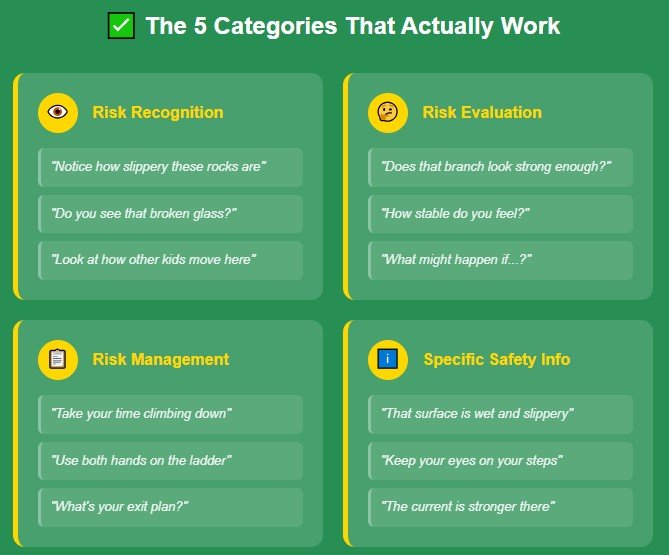
Instead of that one-size-fits-all “be careful,” child development experts recommend five categories of empowering language that build safety skills:
1. Risk Recognition Phrases
Help your child notice their environment:
- “Notice how slippery these rocks are.”
- “Do you see that broken glass over there?”
- “Look at how the other kids are moving on this equipment.”
2. Risk Evaluation Questions
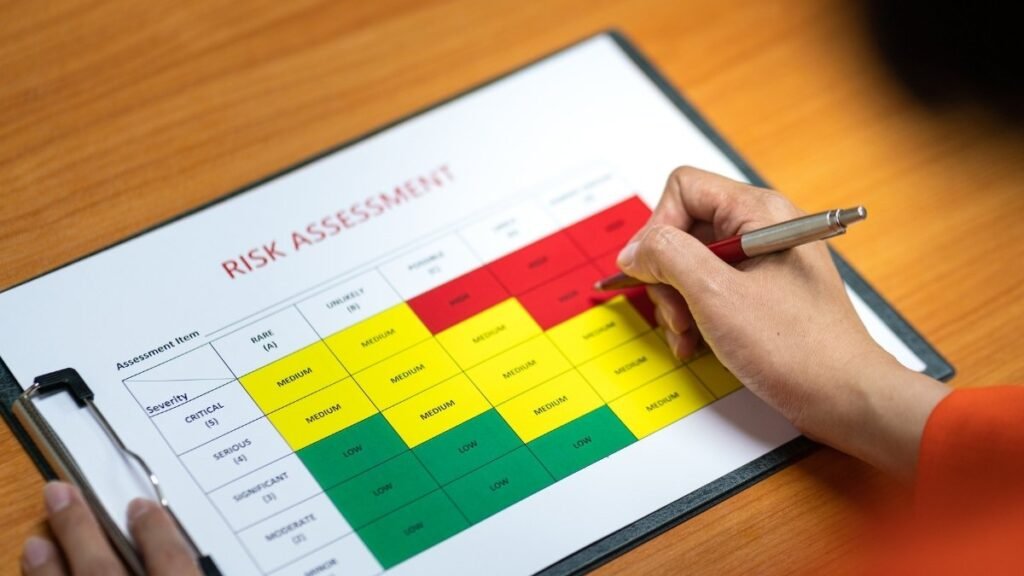
Encourage them to assess the situation:
- “Does that branch look strong enough to hold you?”
- “How stable do you feel on that rock?”
- “What do you think might happen if…?”
3. Risk Management Guidance
Give specific, actionable direction:
- “Take your time climbing down.”
- “Use both hands on the ladder.”
- “What’s your plan for getting back down?”
4. Specific Safety Information
Provide concrete, useful details:
- “Keep your eyes on where you’re stepping.”
- “That surface is wet and slippery.”
- “The current is stronger near those rocks.”
5. Encouraging Questions
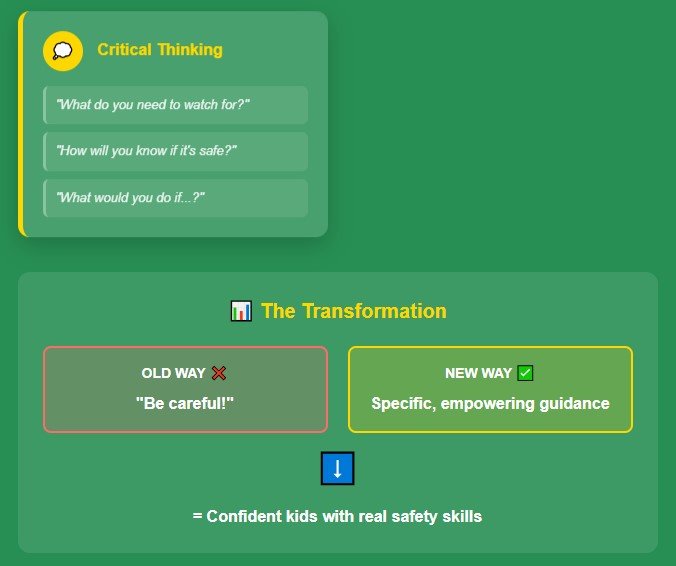
Develop their critical thinking:
- “What do you need to watch out for here?”
- “How will you know if it’s safe to continue?”
- “What would you do if you felt stuck?”
Your Child’s Brain on Safety Talk

This is where things get fascinating. Neuroscience research shows that parental language literally shapes children’s developing brains.
When you use fear-based communication (like “be careful!”), It activates the amygdala – the brain’s alarm system. This triggers fight-or-flight responses instead of thoughtful decision-making.
But when you use collaborative language, you’re activating the parts of their brain responsible for problem-solving and flexible thinking. You’re helping them build stronger neural pathways for confident decision-making.
Pretty amazing, right?
The Harvard Study That Changes Everything

Harvard’s Center on the Developing Child found something counterintuitive: children who experience appropriate “positive stress” develop stronger resilience and better risk assessment abilities than those shielded from all potential dangers.
What’s positive stress? It’s manageable challenges with parental support. Think of climbing a tree with you nearby, not climbing it alone without any guidance.
Age-Specific Strategies That Work
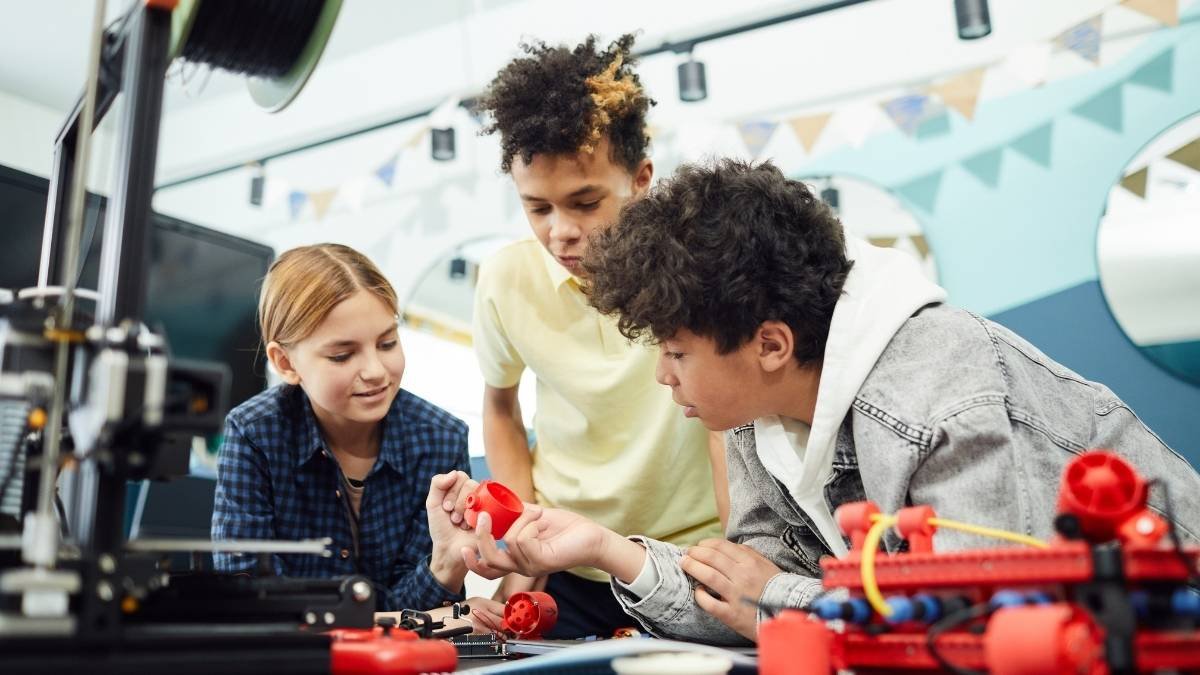
The key is adapting your approach to your child’s developmental stage. Here’s what works at different ages:
Toddlers (1-3 years)
Keep it simple and concrete:
- “Look up” (for spatial awareness)
- “Hot stove” (immediate danger)
- “Two feet on the ground” (specific instruction)
Preschoolers (3-6 years)
Start engaging their reasoning:
- “Why do you think we wear helmets when biking?”
- “What might happen if we run by the pool?”
- “Show me how you’ll get down safely.”
School-age kids (6-12 years)

Go deeper with problem-solving:
- “Walk me through your plan for this climb.”
- “What are all the things you need to consider here?”
- “How will you know if you need help?”
Teens
Collaborate on risk assessment:
- “What do you think about the safety of this situation?”
- “Help me understand your thought process here.”
- “What backup plans do you have?”
Real Talk: Making the Switch
Building confident risk assessment takes time.
I get it. Breaking the “be careful” habit is harder than it sounds. You’ve probably said it a thousand times without thinking. That’s normal!
Here’s a simple four-step framework to help you transition:
1. STOP – Notice when you feel the urge to say “be careful” 2. BREATHE – Take a moment to assess the actual vs. perceived danger 3. REFLECT – Ask yourself what specific information would be helpful 4. RESPOND – Use one of the five categories above, or simply stay supportively quiet
Start Small
You don’t have to overhaul everything overnight. Pick one or two phrases that feel natural to you and practice using them. The goal isn’t perfection – it’s progress.
The Surprising Research Findings

Here are some eye-opening discoveries from recent studies:
Parental anxiety significantly impacts children’s safety outcomes. Kids with anxious parents become more fearful and less resilient, actually ending up less safe than those whose parents stayed calm while teaching practical skills.
Children often respond better to peer learning than adult-directed approaches. Sometimes the best safety teacher for your kid is another kid who’s figured out how to navigate a challenge successfully.
The language patterns children hear regularly literally shape their neural pathways. Fear-based communication builds anxiety circuits, while empowering language builds problem-solving circuits.
Cultural Considerations

Something important to note: most safety communication research has focused on Western, middle-class families. Different cultures approach risk and safety communication very differently, and what works in one context might not work in another.
The key is adapting these principles to your family’s values and cultural background while maintaining the core focus on building skills rather than transferring fear.
Your Action Plan for Safer, Braver Kids
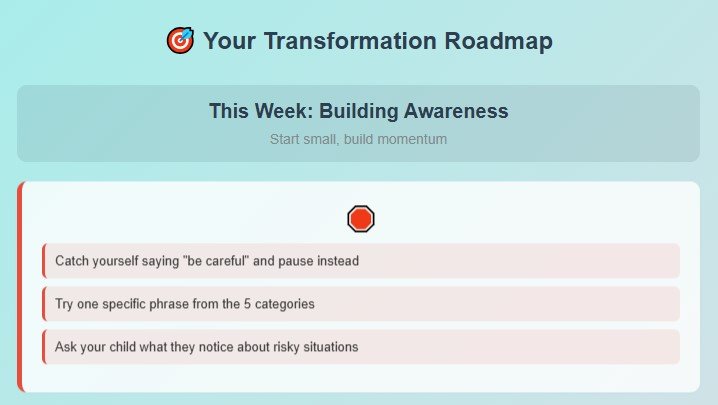
Ready to make some changes? Here’s where to start:
This Week:

- Catch yourself saying “be careful” and pause instead
- Try one specific phrase from the categories above
- Ask your child what they notice about risky situations instead of pointing out the dangers yourself
This Month:
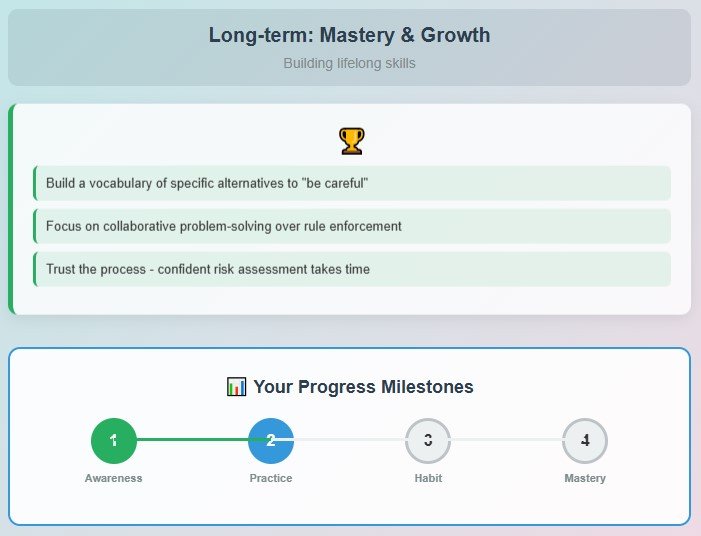
- Practice the four-step framework until it becomes more natural
- Involve your child in creating family safety rules together
- Look for opportunities to let them assess and manage age-appropriate risks
Long-term:
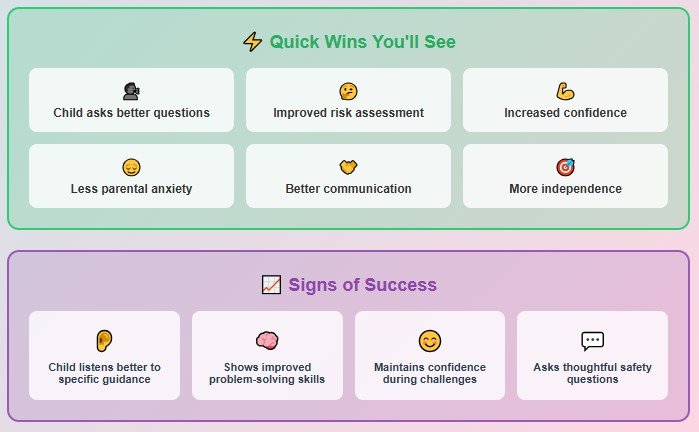
- Build a vocabulary of specific alternatives to “be careful.”
- Focus on collaborative problem-solving rather than rule enforcement
- Trust the process – building confident risk assessment takes time
The Bottom Line
There’s no magic list of 13 phrases that will transform your parenting overnight. However, there is something even better: a research-backed approach that develops your child’s actual safety skills while preserving their natural confidence and curiosity.
The goal isn’t to eliminate all risks – it’s to raise kids who can think critically, assess situations accurately, and make smart decisions even when you’re not around.
Your child doesn’t need you to point out every potential danger. They need you to help them develop the skills to recognize and navigate challenges on their own.
That’s how we raise the brave, safety-aware kids our world needs.
What’s one situation where you find yourself saying “be careful” most often? Try replacing it with a specific question or observation this week and see what happens. Your future self (and your more confident kid) will thank you.




